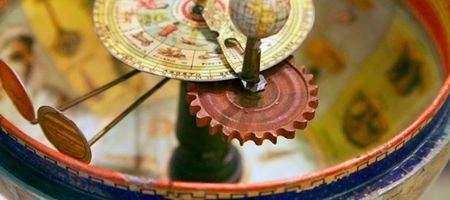A mysterious 100-year-old Spanish globe appears to be an interactive teaching aid – ‘perhaps the Wikipedia of its day’, say researchers.

Object Wh.5892, held at the University of Cambridge’s Whipple Museum of the History of Science, contains quite a few surprises. Lifting the northern hemisphere reveals volcanoes erupting, a mammoth lifting its tusks and dinosaurs fighting, along with a planetarium.
“Making a globe like this would have been technically difficult: apart from the construction of the globe from brass, wood and pasteboard, the inside of the sphere is hand-covered with encyclopaedic information designed expressly for the object and printed using the latest chromolithographic technology,” says researcher Seb Falk.
“All in all, it’s rather surprising that such an object was made in Spain, a country where there was no previous tradition of globe making.”
Falk believes that the globe – marked with marking it with the company stamp of Benjamín Tena of Valencia – may have been made as a prototype for a toy that was never mass produced.
“International trade had expanded hugely in the late 19th century and there was a flourishing intra-European trade in scientific instruments and educational products,” says Falk.
“The globe’s maker may have imitated foreign models produced in Central Europe and then collaborated with an established publisher. Recent developments in printing technology were vital to the production of such a beautiful, brightly coloured toy.”
Falk was able to date the globe by using cartographic evidence such as the presence of the border between Norway and Sweden, together with information in the encyclopaedic entries on the names of plants and animals – and even the use of accents in Spanish words that lost them suddenly in the first decade of the 20th century. All point towards the maker having made the globe around 1907.
Around this time, there was strong pressure form the Spanish media to improve the country’s education system, with a shift towardssmall-group education based on experimentation – for which the globe would have been perfect.
“Although what one might ordinarily want to do with a globe – spin it – is almost impossible, it is clearly intended to be touched. The planetarium is sized to fit a child’s hand, with instructions designed to be read aloud: ‘if we place the little lunar globe in a straight line between the earth and the sun, the moon will block the sun’s light…. we thus have a solar eclipse.’” says Falk.






